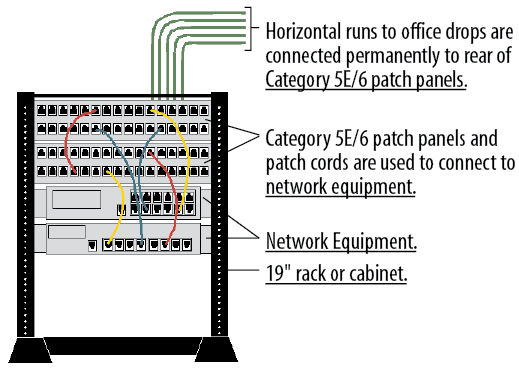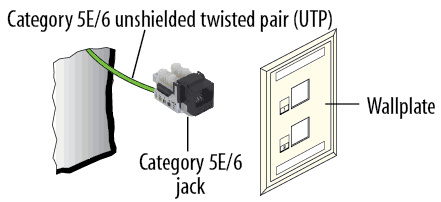An Ethernet network is composed of three things: active equipment (routers, switches, AP's, servers, etc.), passive equipment (bulk cable, cable assemblies, connectors, adapters, jacks, antennas, etc.), and a framework (racks, enclosures, patch panels, cable run ladders, faceplates at the drop point, etc.). Today, I'd like to talk about the third part: the network framework.
It seems strange to me that the framework is often the last thing thought of when building a network. In reality, it should be the first. The framework is the skeleton on which everything else hangs, and without which the whole network becomes unwieldy, awkward, and difficult to manage. This is especially true for larger networks, like in large office buildings, factories, and campuses. If you go out and buy all the active and passive equipment first, you're setting yourself up for big headaches when it comes time to put it all together. The framework comes first in all but the most rudimentary home network.
It starts with a plan Before you do anything, step back and take a look at the physical structure of your network. Do you already have the beginning of a framework, such as a wiring room or closet, pre-run in-wall wiring and wall jacks at the various drop points? If not, that's where you should start. Depending on the overall size of your network, you will need a secure room large enough to centralize the common network equipment like routers, switches and servers. Next, you will need cables run from that closet to the drop points. Finally, each drop point needs a way to connect in to the network, using either an Ethernet jack mounted on a faceplate, or a surface-mount Ethernet box.
Before you do anything, step back and take a look at the physical structure of your network. Do you already have the beginning of a framework, such as a wiring room or closet, pre-run in-wall wiring and wall jacks at the various drop points? If not, that's where you should start. Depending on the overall size of your network, you will need a secure room large enough to centralize the common network equipment like routers, switches and servers. Next, you will need cables run from that closet to the drop points. Finally, each drop point needs a way to connect in to the network, using either an Ethernet jack mounted on a faceplate, or a surface-mount Ethernet box.
Spend some time thinking about the ideal setup for these three areas. Wiring rooms often need to be ventilated or cooled and should be large enough to expand in if you need to. The wiring should be extensive enough to accommodate the shifting of cubicles, offices or factory setups in the future, and it must be up to local fire and building codes. Drop points should be aesthetic enough to blend in with the office décor but still be clearly marked so someone months or years later doesn't have to guess what the port is for.
Racks and cable managementProbably the most expensive and time consuming part of your framework is running the cables to the drop points. But after that is the rack and cable management equipment. It may be tempting to go cheap on this, but think before you do so. Beyond just the quality of the rack equipment construction, you must make sure it fits in your overall plan. It has to be the right size and height to fit your equipment. It must have proper thermal management. Keep in mind that, while the rack itself is probably semi-permanent, the equipment and configurations on it are anything but. So the rack must be in a position where someone can get to it, behind it, and around it to do the work. The harder you make it to maneuver around your rack setup, the bigger the risk of expensive and time-consuming challenges somewhere in the future. Consider tilt or swinging pivot style racks if possible.
 It's also a good idea to think a little about wire and cable management. A wiring room can easily become a mess of spaghetti-like bundles of cable. Cables get looped on the floor where they can be stepped on, they get bent at weird angles to reach the ports, they get stretched and twisted and crowded together. Investing in various types of cable management equipment where cables can be gently routed around to wherever they need to go will help a lot as your network grows and changes. Also think about innovative solutions like cables with boots specifically made for crowding, or right-angle cable assemblies that prevent kinking and crushing.
It's also a good idea to think a little about wire and cable management. A wiring room can easily become a mess of spaghetti-like bundles of cable. Cables get looped on the floor where they can be stepped on, they get bent at weird angles to reach the ports, they get stretched and twisted and crowded together. Investing in various types of cable management equipment where cables can be gently routed around to wherever they need to go will help a lot as your network grows and changes. Also think about innovative solutions like cables with boots specifically made for crowding, or right-angle cable assemblies that prevent kinking and crushing.
Wireless Ethernet has come a long way since the early days of the IEEE 802.11 standards. Modern WiFi has speed and performance to rival wired networks in many environments. But don't think you won't need a framework if you're setting up your building with wireless Ethernet. Wireless technology still requires about the same, and sometimes more, active equipment to run efficiently. And that active equipment needs somewhere to go. Furthermore, you can't have a wireless network without an antenna somewhere. Even the cutting-edge MESH network technology needs at least one antenna with good gain to function. And even today, wireless networks are not quite as reliable as wired networks, meaning it's often a good idea to run at least some cables in your building to compensate for low signal strength and signal outages common to wireless LANs.
L-com sells both Middle Atlantic Products and its own brand of quality racks, panels and enclosures. Also, they have over 200 models of 2.4 GHz WiFi antennas for IEEE 802.11a/b/g/n and other networking applications.

No comments:
Post a Comment